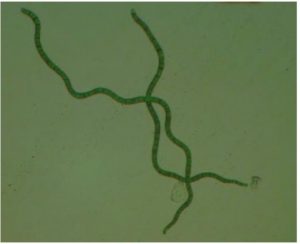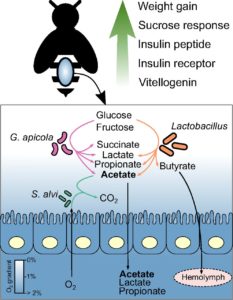USDA-ARS Honey Bee Laboratory in Baton Rouge, LA, was established 92 years ago. This month, researchers in the laboratory publish new work on three diverse research topics, at the intersection of honey bee health, nutrition, and honey bee microbiome.
A brand new nutrition – spirulina

(Michele Greque de Morais, et al. Biomed Res Int. 2014)
Honey bees get their protein from pollen. During pollen dearth, beekeepers supplement managed honey bee colonies with various pollen substitutes. Spirulina has been proposed as a protein source for honey bees and recently became commercially available to beekeepers (Healthy Bees LLC).
Spirulina is the common name for the product produced from cultures of the photosynthetic prokaryotic cyanobacteria Arthrospira platensis, the natural habitat of which is alkaline lakes. In South America, it has been cultivated as a food supplement since the time of the Aztecs, about 400 years ago. It is gaining prominence as a food supplement for humans and honeybees. The objective of this study was to asses the potential of spirulina as a nutrition supplement for honey bees.
Experimental setup
N: 50 bees per cage, 12-13 cages per treatment, 2 replicate tests conducted.
Location: USDA ARS honey bee lab, Baton Rouge, LA, USA
Setup: Newly emerged workers were obtained from healthy hives and kept in cages. Bees housed in cages were fed with the following diets: (1) sucrose only; (2) sucrose and polyfloral pollen (3) sucrose and a commercially available pollen substitute; and (4) sucrose and spirulina.
Methods: Diet consumption was monitored after 5 and 10 days. Bees were dissected into head, thorax, abdomen. Fat body mass was determined and guts were analyzed for gut bacteria abundance using molecular methods.
Results: Spirulina was confirmed as a good source of amino acids and lipids.
Bees did not eat as much spirulina(4) as they did other diets. Diet consumption was highest in cages fed pollen(2) and lowest in cages fed spirulina(4). However, negligent mortality indicated that the bees were not starved. Spirulina(4) group had the highest thorax weight. Head protein content, vitellogenin levels and fat body mass as good as the pollen group(4), indicating that the nutrients in spirulina(2) diet were in fact assimilated, or used, by the bees.
Additionally, gut bacteria abundance was highest in bees fed spirulina(4) and lowest in bees fed pollen substitute(3) or sucrose(1). The analysis included Lactobacillus, Bifidobacterium, and Snodgrassella bacteria. This finding shows prebiotic potential of spirulina (positive effect on beneficial gut bacteria).
Propolis appears to suppress some members of honey bee gut microbiota

Propolis is the plant and tree resins collected by honey bees and deposited on hive walls.
Propolis not only has an architectural purpose but also has many documented antimicrobial activities.
The objective of a study conducted by scientists from USDA, University of Minnesota, and Alberta Beekeepers Commission, was to find out how propolis affects honeybee gut and hive microbiome.
Experimental Setup:
N: 62 samples
Location: Minnesota
Methods: 24 colonies; 12 of which were control (propolis-poor) and 12 others were made propolis-rich with propolis traps installed on all four inside walls of each bee box. Newly emerged bees were marked and released back to the hive. Six days later, the marked bees were collected and frozen for 16S rRNA microbiome analysis.
Results: Snodgrassella, Bartonella, Lactobacillus, Bifidobacterium, Frischella, Gilliamella bacterial taxa were detected in both propolis-rich and propolis-poor hives.
Significant differences were found in two taxa, Bartonella and Lactobacillus, which were less abundant in propolis-rich bees. At the same time, Bartonella and Lactobacillus were more abundant in propolis-rich than propolis-poor bees.
These findings provide some insight to how propolis can disrupt honeybee gut homeostasis. Future work will further characterize the impact propolis has on pathogens and honey bee colony health.
Digging deeper into the role of gut bacteria metabolites in bee nutrition

The role of gut bacteria in pollen fermentation is not well understood. Gut bacteria produce nutrition molecules called organic acids (OAs), also known as short-chain fatty acids (SCFA’s) when they ferment various components of host diets.
Experimental Setup
N: 16-19 cages; 3 groups; 65 bees/cage
Location: Tucson, Arizona, USA
Methods: Newly emerged bees from 12 healthy colonies were put into cages and fed (1) sucrose only; (2) polyfloral pollen and sucrose; (3) sucrose and organic acid sodium salts (acetate, lactate, butyrate, formate, succinate). Bees from experiment were dissected and molecular analysis of bacterial abundance, fermentative enzyme expression, and honeybee enteroendocrine signaling genes was analyzed using molecular methods.
Results: The study detected hundreds of millions of gut bacteria associated with anterior rectum. Lack of pollen in bee’s diet lead to significantly reduced bacterial abundance in the anterior rectum, and decrease in the fermentative enzymes the bacteria normally express.
A major finding of this study is that the pollen restriction reduces gut bacteria, and therefore organic acids (OAs) acetate and lactate production. It confirms that undigested pollen is indeed a microbiota growth substrate and a source of bacterial fermentation products and metabolites that feed the bees.
OA’s can modulate enteroendocrine signaling of the host. Accordingly, transcript expression of enteroendocrine signaling genes was influenced by the diet. Interestingly, feeding OAs to pollen starved bees can re-normalize their energy metabolism. These metabolites are produced by gut bacteria from pollen. Understandably, OA feeding did not improve gut bacteria abundance in pollen-starved bees.
